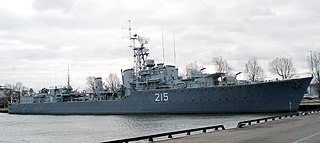Three ships of the British Royal Navy have borne the name HMS Zulu, after the African Zulu people:
Two ships of the Royal Navy have borne the name HMS Afridi, after the ethnic group, the Afridi:
Three ships of the Royal Navy have been named HMS Gurkha, while two have been named HMS Ghurka, after a people who originate in Nepal and who serve with distinction in the British Army as part of the Brigade of Gurkhas.
Thirteen vessels of the Royal Navy have borne the name HMS Mohawk, after the Mohawk, an indigenous tribe of North America:

The Tribal class, or Afridi class, were a class of destroyers built for the Royal Navy, Royal Canadian Navy and Royal Australian Navy that saw service in World War II. Originally conceived during design studies for a light fleet cruiser, the Tribals evolved into fast, powerful destroyers, with greater emphasis on guns over torpedoes than previous destroyers, in response to new designs by Japan, Italy, and Germany. The Tribals were well admired by their crews and the public when they were in service due to their power, often becoming symbols of prestige while in service.

The first HMS Zulu was a Tribal class destroyer launched 16 September 1909 at Hawthorn Leslie Shipyard and commissioned in March 1910. She was mined during the First World War, on 27 October 1916 off Dover in a minefield lain by the Imperial German submarine UC-1. Her stern was blown off and sank, but the forward section remained afloat. It was towed into port and attached to the stern of Nubian, which had been torpedoed, to form a new destroyer named HMS Zubian.

HMS Zubian was a First World War Royal Navy Tribal-class destroyer constructed from the forward end of HMS Zulu and the rear and mid sections of HMS Nubian. These two destroyers had been badly damaged in late 1916, and rather than scrapping both hulls at the height of World War I, the Admiralty ordered that they be rebuilt as the composite Zubian and put back into service. She was commissioned into the fleet in June 1917. The name Zubian is a portmanteau of the names of the original ships.
Six ships of the Royal Navy have borne the name HMS Cossack, after the Cossack people of Eastern Europe, whilst another was begun but was cancelled while building:
There have been two Royal Navy ships called HMS Maori after the indigenous people of New Zealand:
Two ships of the Royal Navy have been named HMS Ashanti after the Ashanti people.

HMS Nubian was a Royal Navy Tribal-class destroyer. She was launched in 1909 and torpedoed in 1916. With her bow blown off, the wreck was used to create a new ship by joining the bow of another destroyer of the same class, HMS Zulu. The resulting ship was given the portmanteau name HMS Zubian. She went on to sink the U-boat SM UC-50 in 1918 and was scrapped in 1919.

HMS Ghurka was a Tribal-class destroyer built in 1907 for the Royal Navy. She served as part of the Dover Patrol during the First World War, playing a part in the sinking of the German submarine U-8 in 1915, and was sunk by a German mine in 1917.
Three ships of the Royal Navy have borne the name HMS Sikh, after the Sikhs, who formed a large part of the community in the Punjab region during British rule there:

HMS Nubian was a Tribal-class destroyer of the Royal Navy that saw much distinguished service in World War II. She won 13 battle honours, a record only exceeded by one other ship, and matched by two others.

HMS Viking was a Tribal-class destroyer of the Royal Navy launched in 1909 and sold for scrap in 1919. She was the only destroyer ever to have six funnels.

HMS Mohawk was a Tribal class destroyer of the Royal Navy launched in 1907 and sold for scrap in 1919.

HMS Cossack was a Tribal class destroyer of the Royal Navy launched in 1907 and sold in 1919.

HMS Tartar was a Tribal-class destroyer of the Royal Navy launched in 1907 and sold in 1921. During the First World War she served in the North Sea and the English Channel with the 6th Destroyer Flotilla.
Māori or Maori can refer to:

The Battle of Dover Strait that occurred on 26–27 October 1916 was a naval battle of the First World War between Great Britain and the German Empire. Two and a half flotillas of German torpedo boats from the Flanders Flotilla launched a raid into the Dover Strait in an attempt to disrupt the Dover Barrage and destroy whatever Allied shipping could be found in the strait.
This page is based on this
Wikipedia article Text is available under the
CC BY-SA 4.0 license; additional terms may apply.
Images, videos and audio are available under their respective licenses.










